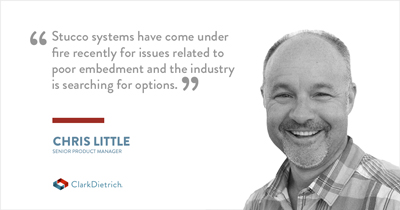Senior Product Manager Chris Little has nearly 20 years of experience in new product development and management and has also played an integral role in helping shape industry standards for lathing, plastering, installation of masonry and stone. He is currently a member of the ASTM C-11 Lathing and Plastering Subcommittee task group, which is continuously updating ballot items to refine the ASTM C-1063 lath installation standard.

We recently checked in with Chris to take the temperature of the plaster and lath industry and find out what issues on the horizon will have the biggest impact on the category going forward.
Q: What issues specific to the plaster and lath industry have been keeping you busy lately?
A: Stucco embedment is undoubtedly the biggest issue for the plaster and lath industry. Stucco systems have come under fire recently for issues related to poor embedment and the industry is searching for options. ClarkDietrich is considering ways to design easy embedment into the components we manufacture. Our initial introduction to the contractors and homebuilders in markets like Florida has been overwhelmingly accepted as a problem-solving component. We are calling this the “Easy Embedment System” and it’s gaining traction.
Q: Why is embedment so important?
A: Embedment is important because when the plaster system is fully embedded, the cementitious material acts compositely with the wire reinforcement and it also mitigates oxidation to the ferrous metal surface. It’s similar to the way re-bar reinforces in concrete, and the concrete covers/protects the re-bar from rust. Embedment is the golden key to long-term performance of the stucco cladding.
Q: Are there any new code issues affecting the category?
A: The evolution of continuous insulation systems on the outside of the building envelope is starting to change the way we design and shape accessories to accommodate the additional insulation for lath and plaster. At this point, the ASTM C-11 Committee has not addressed it, so manufacturers are introducing proprietary solutions. Also, the addition of rain screens to provide a capillary break in moisture movement may be approved in this International Building Code cycle in Year 2021.
Q: You’ve written previously about the activities of the ASTM C-11 Stucco Work Group—has anything noteworthy come out of that group recently?
A: The ASTM C-11 Committee, specifically the C-1063 Task Group, is meeting “virtually” every month to examine and review proposed changes and modifications. Those are discussed in detail on the conference call and all points of view are considered. Any hidden agendas are exposed (I believe) and what surfaces are the issues to be balloted at the semi-annual voting sessions and meetings, administered by ASTM.
Items proposed recently with ASTM modifications include lath laps, accessory attachment modifications, and updates to fastening tables. But, by far the most controversial issue has been how to properly install control joints into the lathing system. This topic has been hotly debated and there are two distinct differences of opinion among the C-1063 Task Group and ASTM sub-committee. One is to remain with current ASTM verbiage of discontinuous lath at control joints (i.e. cutting the lath for control joint placement) and the other, to permit the installer to place the control joint on top of continuous lath, without cutting/tying into the lath plane.
Q: What’s the biggest challenge stucco contractors are facing right now?
A: The fear of litigation is the biggest problem for the stucco contractor. This goes back to the problem of proper embedment that I mentioned earlier. The key for manufacturers is providing products, systems and installation details that make it easier for the contractor to achieve proper embedment. Everyone wins, including the owner, who gets a premium looking finish on their building.
Stucco has been around for centuries because it looks better and lasts longer. Additionally, industry associations like AWCI offer programs and access to peer groups that help contractors navigate these types of challenges.
Q: What is ClarkDietrich doing to alleviate these pain points?
A: As I stated earlier, the introduction of the ClarkDietrich Easy Embedment System (EES) allows the stucco applicator to use similar installation techniques they are familiar with and do so using newly designed components which greatly improve the chances for better installation performance. EES allows for better stucco embedment leading to reduced cracking and less water infiltration, which ultimately reduces opportunity for rusting. The EES consists of Structa-Wire® welded wire lath rolls with a more open wire design to apply the scratch coat. Additionally, the PVC lath accessories with the E-Flange™ design allow the applicator to easily embed the accessory flange and simply wire tie the control joint through the raised rib in the E-Flange. The EES is a win for everyone: it offers simple and fast installation for the installer and results in a stucco wall with less cracking and less water infiltration for the homebuilder.